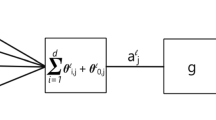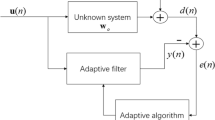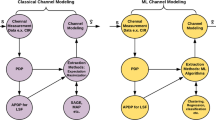Abstract
In blind channel equalization, the use of criteria from the field of information theoretic learning (ITL) has already proved to be a promising alternative, since the use of the high-order statistics is mandatory in this task. In view of the several existent ITL propositions, we present in this work a detailed comparison of the main ITL criteria employed for blind channel equalization and also introduce a new ITL criterion based on the notion of distribution matching. The analyses of the ITL framework are held by means of comparison with elements of the classical filtering theory and among the studied ITL criteria themselves, allowing a new understanding of the existing ITL framework. The verified connections provide the basis for a comparative performance analysis in four practical scenarios, which encompasses discrete/continuous sources with statistical independence/dependence, and real/complex-valued modulations, including the presence of Gaussian and non-Gaussian noise. The results indicate the most suitable ITL criteria for a number of scenarios, some of which are favorable to our proposition.










Similar content being viewed by others
Notes
The global maxima of the RD and RC criteria were obtained considering a unity norm restriction over the filter coefficients.
References
A. Benveniste, M. Goursat, G. Ruget, Robust identification of a nonminimum phase system: blind adjustment of a linear equalizer in data communications. IEEE Trans. Autom. Control AC–25(3), 385–399 (1980)
I. Boussaïd, J. Lepagnot, P. Siarry, A survey on optimization metaheuristics. Inf. Sci. 237, 82–117 (2013)
T.M. Cover, J.A. Thomas, Elements of Information Theory (Wiley, New York, 1991)
D. Erdogmus, Information Theoretic Learning: Rényi’s Entropy and Its Applications to Adaptive System Training. Ph.D. thesis (University of Florida, 2002)
D.G. Fantinato, R.R.F. Attux, A. Neves, R. Suyama, J.M.T. Romano, Blind Deconvolution of Correlated Sources Based on Second-Order Statistics. XXXI Simpósio Brasileiro de Telecomunicações (2013)
D.G. Fantinato, L. Boccato, A. Neves, R.R.F. Attux, Multivariate PDF Matching via Kernel Density Estimation, in IEEE Symposium Series on Computational Intelligence (SSCI) (2014)
G. Foschini, Equalization without altering or detecting data. AT&T Tech. J. 64(8), 1885–1911 (1985)
D. Godard, Self-recovering equalization and carrier tracking in two-dimensional data communication systems. IEEE Trans. Commun. COM–28(11), 1867–1875 (1980)
A. Gunduz, J. Principe, Correntropy as a novel measure for nonlinearity tests. Signal Process. 89, 14–23 (2009)
S. Haykin, Adaptive Filter Theory, 3rd edn. (Prentice Hall, Englewood Cliff, 1996)
N. Kim, A study on the complex-channel blind equalization using ITL algorithms. J. Korean Inf. Commun. Soc. 35(8), 760–767 (2010)
N. Kim, L. Yang, A new criterion of information theoretic optimization and application to blind channel equalization. J. Internet Comput. Serv. 10(1), 11–17 (2009)
M. Lázaro, I. Santamaría, D. Erdogmus, K. Hild, C. Pantaleón, J.C. Principe, Stochastic blind equalization based on PDF fitting using parzen estimator. IEEE Trans. Signal Process. 53(2), 696–704 (2005)
M. Lázaro, I. Santamaría, C. Pantaleón, D. Erdogmus, K. Hild, J.C. Principe, Blind equalization by sampled PDF fitting, in Proceedings of the Fourth International Symposium Independent Component Analysis Blind Equalization, Nara, Japan, 2003, pp. 1041–1046
M. Lázaro, I. Santamaría, C. Pantaleón, D. Erdogmus, J.C. Principe, Matched PDF-based blind equalization, in IEEE International Conference on Acoustics, Speech, and Signal Processing, vol. 4, pp. IV-297–300 (2003)
R. Li, W. Liu, J.C. Principe, A unifying criterion for instantaneous blind source separation based on correntropy. Signal Process. 87, 1872–1881 (2007)
W. Liu, P.P. Pokharel, J.C. Principe, Correntropy: a localized similarity measure, in International Joint Conference on Neural Networks, Vancouver, Canada, pp. 4919–4924 (2006)
J. Montalvão, C. Cavalcante, B. Dorizzi, J. Mota, A Simple PDF Fitting Approach for Blind Equalization. XVIII Simpósio Brasileiro de Telecomunicações (2000)
A. Neves, C. Wada, R. Suyama, R. Attux, J.M. Romano, An analysis of unsupervised signal processing methods in the context of correlated sources. Lect. Notes Comput. Sci. 5441, 82–89 (2009)
K. Nose-Filho, D.G. Fantinato, R. Attux, A. Neves, J. Romano, A Novel Entropy-based Equalization Performance Measure and Relations to Lp-Norm Deconvolution. XXXI Simpósio Brasileiro de Telecomunicações (2013)
E. Parzen, On the estimation of a probability density function and the mode. Ann. Math. Stat. 33, 1065–1067 (1962)
J.C. Principe, Information Theoretic Learning Rényi’s Entropy and Kernel Perspectives (Springer, Berlin, 2010)
J.M.T. Romano, R.R.F. Attux, C.C. Cavalcante, R. Suyama, Unsupervised Signal Processing: Channel Equalization and Source Separation (CRC Press, Boca Raton, 2010)
I. Santamaría, C. Pantaleón, L. Vielva, J.C. Principe, A fast algorithm for adaptive blind equalization using order-\(\alpha \) Renyi’s entropy. IEEE Trans. Acoust. Speech Signal Process. 2(1), 2657–2660 (2002)
I. Santamaría, C. Pantaleón, L. Vielva, J.C. Principe, Adaptive blind equalization through quadratic PDF matching. Proc. Eur. Signal Process. Conf. II, 289–292 (2002)
I. Santamaría, P. Pokharel, J.C. Principe, Generalized correlation function: definition, properties and application to blind equalization. IEEE Trans. Signal Process. 54(6), 2187–2197 (2006)
O. Shalvi, E. Weinstein, New criteria for blind deconvolution of nonminimum phase systems (channels). IEEE Trans. Inf. Theory 36(2), 312–321 (1990)
C.E. Shannon, A mathematical theory of communication. Bell Syst. Tech. J. 27(379–423), 623–656 (1948)
R. Storn, K. Price, Differential evolution—a simple and efficient heuristic for global optimization over continuous spaces. J. Glob. Optim. 11, 341–359 (1997)
Author information
Authors and Affiliations
Corresponding author
Additional information
This work was supported by FAPESP (2013/14185-2) and CNPq.
Appendix: QD-D and QD-DR Gradient-Based Algorithms
Appendix: QD-D and QD-DR Gradient-Based Algorithms
The stochastic gradient-based algorithms rely on adaptive filters whose weights are updated in every iteration according to
where \(\nabla J({\mathbf {w}}(n))\) is the gradient vector of \(J({\mathbf {w}}(n))\) and \(\mu \) is the step size.
Hence, for the QD-D cost, given by Eq. (19), the gradient is
which can be directly replaced in Eq. (33) to form the QD-D gradient-based algorithm. The term \(1/\sigma ^{2}\) is a common factor that usually is disregarded.
The QD-DR gradient is basically the second term of Eq. (34)—and the factor \(2/\sigma ^{2}\) can be disregarded.
For the continuous counterpart, the samples of s(n) are used instead of the source PMF, and the QD-D (and QD-DR) gradient only differs on the second term, as shown in [12].
Rights and permissions
About this article
Cite this article
Fantinato, D.G., Neves, A. & Attux, R. Analysis of a Novel Density Matching Criterion Within the ITL Framework for Blind Channel Equalization. Circuits Syst Signal Process 37, 203–231 (2018). https://doi.org/10.1007/s00034-017-0543-4
Received:
Revised:
Accepted:
Published:
Issue Date:
DOI: https://doi.org/10.1007/s00034-017-0543-4




